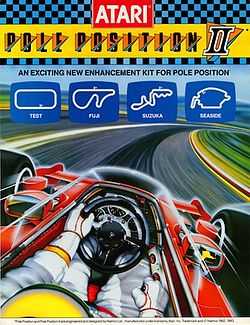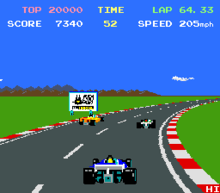Pole Position II
| Pole Position II | |
|---|---|
 North American arcade flyer | |
| Developer(s) | Namco |
| Publisher(s) | |
| Designer(s) | Tōru Iwatani |
| Platform(s) | Arcade, Atari 7800, Commodore 64, Epoch Super Cassette Vision, MS-DOS, Mobile Phone |
| Release date(s) | |
| Genre(s) | Racing |
| Mode(s) | Single player |
| Cabinet | Upright and environmental |
| Arcade system | Namco Pole Position |
| CPU | 1x ZiLOG Z80 @ 3.072 MHz, 2x Z8002 @ 3.072 MHz, 1x MB8844 @ 256 kHz |
| Sound | 1x Namco WSG @ 48 kHz, 1x Namco 52XX @ 1.536 MHz |
| Display | Horizontal orientation, Raster, 256 x 224 resolution |
Pole Position II (ポールポジションII Pōru Pojishon Tsū) is a racing arcade game, released by Namco in 1983. It runs on Namco Pole Position hardware, and, as the name suggests, it is the sequel to Pole Position, which was released in the previous year. As with its predecessor, Namco licensed this game to Atari for US manufacture and distribution, who also released a port of it as the pack-in game for their Atari 7800 Prosystem console.
Gameplay

The gameplay is very much like that of the original Pole Position, except that this time there are slightly improved graphics, a new opening theme, and in addition to the original Fuji racetrack, featured on the cover (above right), by veteran game artist Marc Ericksen, showing Mt. Fuji in the distance, there are three others to choose from: Test (resembling Indianapolis Motor Speedway), Seaside (resembling the 1982 United States Grand Prix West circuit in Long Beach) and Suzuka. The cars also have a different color scheme and the explosions now show debris, while several new billboards have also been introduced. One notable difference between the Japanese and American versions is that while the timer is displayed as "TIME" in the Japanese version (as it was in the original game), it is displayed as "UNIT" in the American version; the reason behind this is unknown.
Legacy
Pole Position II has been re-released as part of various Namco Museum compilations - but presumably due to licensing issues, the Fuji Speedway and Suzuka Circuit were renamed to Namco Circuit and Wonder Circuit (after Namco's Wonder series of Japanese theme parks) respectively. In Namco Museum Virtual Arcade, they were renamed to Blue and Orange respectively, even though neither track features the colors.
In 2006, Namco Networks released this game on the mobile platform, paying attention to details to keep it authentic to the arcade original.[1][2]
References
External links
- Pole Position II at the Killer List of Videogames
- Pole Position II at the Arcade History database